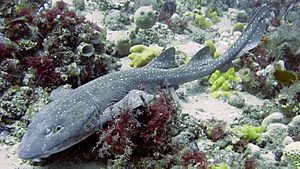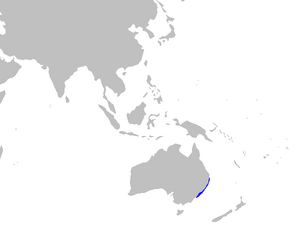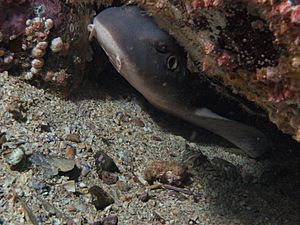Blind shark facts for kids
Quick facts for kids Blind shark |
|
|---|---|
 |
|
| Conservation status | |
| Scientific classification | |
| Genus: |
Brachaelurus
|
| Species: |
waddi
|
 |
|
| Range of the blind shark | |
| Synonyms | |
|
Chiloscyllium furvum Macleay, 1881 |
|
The blind shark (Brachaelurus waddi) is a type of carpet shark. It is one of two species in its family, the Brachaeluridae. This shark lives along the eastern coast of Australia. It is active at night and stays near the ocean bottom. You can often find it in rocky areas and seagrass beds. It lives from the shallow intertidal zone down to about 140 meters (460 feet) deep. Sometimes, it gets stuck in tidal pools when the tide goes out. But don't worry, it can survive out of water for a long time!
Blind sharks grow to about 62–66 cm (24–26 inches) long. They have a sturdy, grayish to brownish body. Young sharks have white spots and dark bands, which fade as they get older. Their head is wide and flat with small eyes on top. They also have two long feelers called barbels under their snout. This shark mainly eats small invertebrates and bony fishes. Female blind sharks give birth to 7–8 live pups in the summer. These sharks do well in aquariums. They are not usually caught by fishers, and if they are, they often survive. Because of this, the International Union for the Conservation of Nature (IUCN) lists the blind shark as a species of Least Concern.
Contents
About the Blind Shark's Name
The blind shark was first described in 1801 by German naturalists Marcus Elieser Bloch and Johann Gottlob Schneider. They named it Squalus waddi. In 1907, James Douglas Ogilby created the name Brachaelurus for this shark. This name comes from Greek words meaning "short" and "cat."
Even though it's called the blind shark, it can see perfectly well! Anglers gave it this name because it pulls its eyeballs back and closes its thick lower eyelids when it's taken out of the water. This special ability helps it survive for up to 18 hours out of water. This is useful if it gets stranded by the tide.
Where Blind Sharks Live
The blind shark only lives along the eastern coast of Australia. You can find it from Mooloolaba in southern Queensland to Jervis Bay in New South Wales. It is a bottom-dwelling species. It usually lives on the continental shelf, from the very shallow intertidal zone to about 73 meters (240 feet) deep. However, it has been seen as deep as 140 meters (460 feet).
Blind sharks prefer rocky areas and nearby seagrass beds. Young sharks often live in areas with strong waves. In Nelson Bay, these sharks have been seen resting openly on top of sponges.
What Blind Sharks Look Like
The blind shark has a strong body and a wide, flat head with a blunt snout. Its small, oval eyes are high on its head. Behind and below the eyes are oval openings called spiracles. The nostrils are near the tip of the snout. They have long, thin barbels and skin flaps. Two clear grooves connect the nostrils to its small mouth. It has many rows of teeth, each with a sharp central point. It has five pairs of small gill slits.
Its pectoral fins are large and wide. The two dorsal fins are about the same size. The first dorsal fin starts above the pelvic fins. The pelvic fins are rounded and almost as big as the pectoral fins. The anal fin is much smaller than the dorsal fins. It is very close to the base of the long, low caudal fin (tail fin). The tail fin makes up about a quarter of the shark's total length. Its skin feels rough because of large dermal denticles. Blind sharks are light to dark brown on top and lighter underneath. Young sharks have dark bands that fade as they get older. They can grow up to 0.9–1.2 meters (3–4 feet) long, but most are smaller.
Blind Shark Habits and Diet
Blind sharks are shy and slow during the day. Adults usually hide in caves or under ledges. Young sharks hide inside cracks in rocks. At night, they come out over reefs and seagrass meadows to find food. They eat small invertebrates like crabs, shrimp, cephalopods (like squid), and sea anemones. They also eat bony fishes. They catch their prey by sucking it in.
The blind shark reproduces every year. Females give birth to 7–8 live pups during the summer. Newborns are about 15–18 cm (6–7 inches) long. Males become mature when they are about 62 cm (24 inches) long. Females mature at about 66 cm (26 inches) long. In captivity, a blind shark has lived for 20 years.
Blind Sharks and Humans
Blind sharks are generally harmless to humans. However, they can bite if they feel threatened. Their strong jaws and powerful suction make them hard to remove if they bite. There are stories of blind sharks biting divers' wetsuits and holding on even after the divers surfaced. They had to be pried off.
This shark is one of the few sharks that can be kept in home aquariums. They are tough, stay small, and don't move around much. However, because they are active at night and like to hide, they can be hard to watch. The Sydney Aquarium has even had success breeding blind sharks in captivity.
Commercial fishers do not usually catch blind sharks. Their meat has a strong ammonia-like taste that is not pleasant. They are sometimes caught by accident in prawn trawl nets. But because they can survive out of water, many of them live after being released. Some recreational fishers catch blind sharks, but they often see them as a bother. Their small mouths and strong jaws make it hard to remove hooks. They are usually too small to get caught in shark nets used to protect beaches. The number of blind sharks caught for the aquarium trade is not thought to be a big problem.
The International Union for the Conservation of Nature (IUCN) has listed the blind shark as a species of Least Concern. This means it is not currently at risk. Its population is still strong, and the threats it faces are not serious. Many of the areas where it lives are also Marine Protected Areas (MPAs).
See also
 In Spanish: Tiburón ciego para niños
In Spanish: Tiburón ciego para niños



